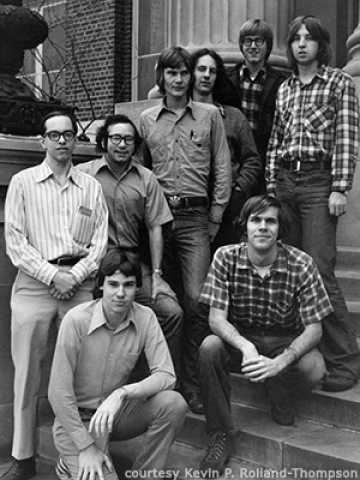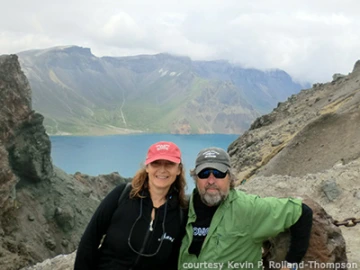Etendue: Kevin P. Rolland-Thompson
Welcome to Etendue, featuring interesting and accomplished individuals known for their leadership and contributions both with their careers and the College of Optical Sciences, in their own words. (For a similar view on the college’s best and brightest – our students – please check out Another Wavelength among our Students in the Spotlight.)
This week, we hear from Kevin P. Rolland-Thompson, Ph.D. 1980.

Where are you from?
I was born and grew up in Minneapolis, Minnesota, specifically the suburb of Edina, graduating from Edina High School in 1972. I received B.S. degrees in physics and astrophysics in 1976 from the University of Minnesota Institute of Technology and then the Ph.D. from the College of Optical Sciences with Roland Shack in 1980.

Who or what influenced your interest in optics?
My interest in optics came through my interest in astronomy. However, this actually came from an intrinsic interest in the history of things, including science. I took an introductory course in astronomy from a professor who had worked on the Manhattan Project and spent a lot of time talking up famous physicists including Gamow and Feynman. After that I simply took whatever class he was teaching, which turned out to be mostly graduate astronomy courses (that I petitioned into). Hence, I quite by accident got a degree in astrophysics. But I worked a summer with an astrophysicist and concluded that wasn’t a passion, so I decided I would design instruments for astronomers as that seemed interesting. This was way before the Internet, so when I learned there were only two schools offering graduate degrees in optics (and particularly optical instruments) I applied to both and went to the one with the most telescopes.
Describe your career.
I started my career as an optical designer at what was then the Perkin-Elmer government division in Connecticut. One of my early projects involved making one of the first diamond-turned 24-inch telescopes. In the mid-1980s, I joined Optical Research Associates, also as an optical designer, in Pasadena. Over time, I became increasingly involved in customer management and transitioned to director in 1992. The last significant optical design job I did was the test setups for the rotationally nonsymmetric mirrors used in the highly successful first Hubble servicing mission. I became the first second-generation executive in the company in 2000. In 2010, ORA was sold to Synopsys where I am now the group director of R&D in optics. I am also a visiting scientist at the University of Rochester Institute of Optics where I am paired with professor Jannick Rolland, Ph.D. 1990, the Brian Thompson (no relation) Professor of Optical Systems Engineering.

Describe your current job.
For the last few years I have continued to be involved in customer acquisition and management for the optical design group at Synopsys. I also travel to typically 15-20 conferences a year around the world giving talks on a mix of the history of optics and the emerging field of freeform optics, the aberration theory of which is actually founded in my Ph.D. work, as was discovered in 2012 by professor Rolland and her student, now-doctor Kyle Fuerschbach. We are now experimenting with being global citizens, moving seasonally between homes on the Finger Lakes in New York, a chalet in Maui and a moulin in Bretagne, France. Nice experiment.
Share your single best OSC experience.
The picnics, of course. But most memorable, I think, was one of those more-than-100-degree days on campus when professor Shack and I ventured to the math department to ask them what the name of the math we seemed to be inventing was. They were somewhat dismissive. I learned years later that we were reinventing geometric (also called Clifford) algebra and that the famous Hamilton had spent 20 years and written 880 unintelligible pages trying to express the theory of optics in this space in the late 1800s.
Why is staying involved with OSC important to you? How are you involved?
Originally, I was involved through recruiting students for Perkin-Elmer and then ORA. More recently, I was invited to join the development board after my mentor, Bob Hilbert, passed away. I made a number of close friends during my time at OSC and we have stayed in touch over 35 years, so visits are always pleasurable. The 50th anniversary celebration at Old Tucson was particularly great as I ran into a number of classmates I had not seen in decades. [Editor's note: Kevin and his wife, Jannick, have also held significant roles in the establishment of four FoTO scholarship endowments.]

Name one neat fact about you.
In 1986, I set out to acquire a copy of Coddington’s book "A Treatise on the Reflexion and Refraction of Light," written in 1829, as I had reinterpreted results that evolved from his original work in my Ph.D. work. I was traveling heavily for ORA, and I would stay in a city or town one extra day, go to a phone booth (remember those?), and then go to as many rare book stores as possible, looking for a copy of Coddington. Along the way I collected over 4,000 books, with about 800 on optical design and optical instruments written before 1930, including Smith’s book from the 1700s and a complete set of the 1823-1825 Edinburgh Encyclopedia edited by David Brewster and, eventually, even a copy of Coddington (it took eight years).
Photos from top: Rolland-Thompson (top right) with University of Minnesota undergraduate physics cohort; with Jannick in Changbai, China, in August 2013; sunrise views from the windows of his Hawaii (left) and New York (right) offices
